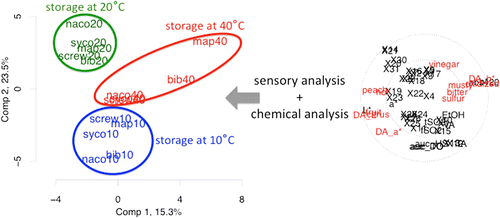Advice for bag-in-box wine drinkers: Keep it cool

Bag-in-box wines are more likely than their bottled counterparts to develop unpleasant flavors, aromas and colors when stored at warm temperatures, a new study has found. Published in ACS' Journal of Agricultural and Food Chemistry, it emphasizes the importance of storing these popular, economical vintages at cool temperatures.
Helene Hopfer and colleagues explain that compounds in wine react with oxygen in the air to change the way wine looks, tastes and smells. These reactions speed up with increasing temperature. Many winemakers are moving away from the traditional packaging for wine—glass bottles sealed with a natural cork stopper—and trying synthetic corks, screw caps or wine in a plastic bag inside a cardboard box. The scientists wanted to find out how this transition might affect the taste and aroma of wine under different storage conditions.
Using chemical analysis and a panel of trained tasters, the authors studied how storage at various temperatures affected unoaked California Chardonnay stored for three months in different wine packaging types: natural and synthetic corks, screw caps and two kinds of bag-in-box containers. Storage temperature had the biggest impact on all of the wines. Bag wine stored at 68 and 104 degrees Fahrenheit aged significantly faster than the bottled counterparts, becoming darker and developing vinegar notes. All the wines they tested aged better when stored at 50 degrees F.
More information:
"The Combined Effects of Storage Temperature and Packaging Type on the Sensory and Chemical Properties of Chardonnay", J. Agric. Food Chem., 2012, 60 (43), pp 10743–10754
DOI: 10.1021/jf302910f
Abstract
Californian Chardonnay was stored in five different wine-packaging configurations at three different temperatures for a period of 3 months to study the combined packaging and temperature effects on the sensory and chemical properties of the wines. A trained descriptive panel evaluated aroma, taste, mouthfeel, and color attributes, and the sensory results were correlated to physical and chemical measurements including volatile compounds, SO2, titratable and volatile acidity, oxygen consumption, and wine color, using partial least squares regression. In general, increased storage temperatures induced the largest changes in the wines; however, significant packaging–temperature effects were found for some attributes as well. Particularly wines stored in bag-in-boxes at 40 °C showed significant increases in oxidized and vinegar aromas and yellow color. Volatile esters also decreased in these wines, while increased levels of compounds generally associated with age- or heat-affected wine were found including 1,1,6-trimethyl-1,2-dihydronaphthalene and furfuryl ether, consistent with previously reported chemical aging reactions. In summary, storing unoaked Chardonnay in different packages significantly changes the sensory and chemical properties depending on the storage temperature. After a storage period of 3 months, bottle storage with various closures (natural cork, synthetic cork, and screw cap) changed the wine in a different way than bag-in-box storage.
Journal information: Journal of Agricultural and Food Chemistry
Provided by American Chemical Society



















